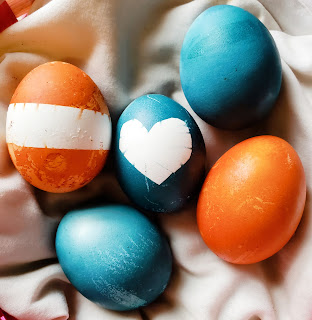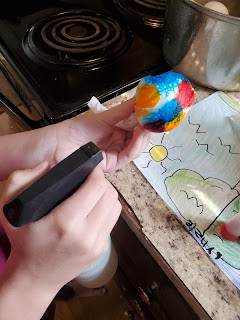Happy spring!
In this post I share a few creative ways to dye Easter eggs!
Try Homemade Natural Dyes
For the last couple years my kids and I have experimented with making homemade natural Easter egg dyes. So far our best results have come from red cabbage and yellow onion skins. Red cabbage makes beautiful blue eggs and yellow onion skins make orange.
To make your dyes you'll need about a cup of red cabbage and a cup of yellow onion skins. Boil a small pot of water for each color. You'll want 2-3 cups of water per pot. Add your plant matter and reduce heat to low. Cover each pot with a lid and let them simmer for about 20-30 minutes.
Let your dyes cool, then strain out the plant matter. Add your dyes to a few glass mason jars and add a hard boiled egg to each jar. Put on the lids and stick in your fridge. Leave the eggs in the dye for an hour or two for lighter shades and overnight for deeper shades.
To make hearts and stripes like the eggs in the photo, cut pieces tape and stick them to the eggs before putting them in the dye. I personally like using electrical tape because it's fairly waterproof and peels off easily. Peel the tape off after the eggs have been removed from the dye and have fully dried.
Make Tie Dyed Eggs with Paper Towels
These turn out really cool, but can be a bit messy so wear a smock or old clothes and maybe some rubber gloves. You'll want something to protect your work surface too, like newspaper or a cheap plastic tablecloth.
To make these eggs you will need:
-hard boiled eggs
-paper towels
-rubber bands
-food coloring
-a spray bottle full of water
Place a hard boiled egg in the center of a paper towel square. Wrap the towel up around the egg and secure in place with a rubber band.
Drop drops of food coloring onto the paper towel. Use different colors and put drops all over egg. You want the egg pretty evenly covered with spots, but try to keep the spots from overlapping.
Spray gently with a spray bottle of water. You want the paper towel to be damp but not soaked.
Set aside in an old egg container until the paper towels are dry. Then unwrap your eggs.
Flower Print Eggs
You can make these cool flower print eggs with any kind of dye. To make them you will need:
-hard boiled eggs
-egg dye
-a pair of nylons
-rubber bands
-fresh flowers and leaves
Start by cutting the pair of nylons into some pieces. They just need to be big enough to wrap around an egg and be held in place with a rubber band.
Choose a flower or leaf. Place it on a hard boiled egg. Carefully wrap the egg with a piece of nylon, securing the flower in place. Use a rubber band to hold the piece of nylon in place.
Set the egg in a cup of dye for the desired amount of time. Remove the egg from the dye and let the excess dye drip off. Then set it aside until it is dry or at least almost dry. Unwrap the egg and peel off the leaf or flower.
If you enjoyed this post check out:
Follow me on










Comments
Post a Comment